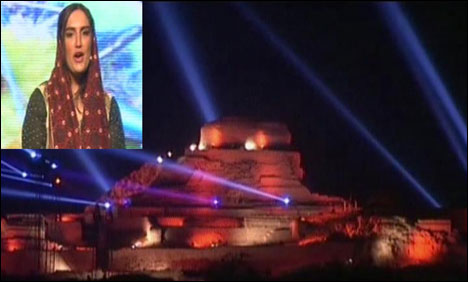
News
Colourful Sindh Festival kicks off at Mohenjodaro
MOHENJODARO: Hoards of holk dancers and singers wearing traditional multicoloured dresses gathered Saturday at one of the world's most ancient archaeological sites in southern Pakistan for a festival that organizers say aspires to promote peace in a nation where political violence has left some 40,000 dead in recent years.
The Sindh Festival at Mohenjodaro aims to publicize the cultural heritage of the country's south. But it drew controversy when some archaeologists said the event, sponsored by a top Pakistani politician, poses a threat to the site's unbaked brick ruins dating to the 3rd millennium BC.
Bilawal Bhutto Zardari, the son of assassinated Pakistani Prime Minister Benazir Bhutto, organized the event at Mohenjodaro, associated with one of the world's first urban societies, the Indus Valley civilization.
Benazir Bhutto was killed in a 2007 gun and bomb attack widely blamed on Pakistani Taliban militants, and Bilawal has made opposition to militancy a pillar of his platform.
Saturday night's event is to begin with a speech by the 25-year-old politician, now heading the Pakistan People's Party that since its beginnings has been associated with the Bhutto-Zardari family. His father served one term as the country's president but it has been the younger Zardari who has become the public face of the party. It is especially strong in Sindh province, the family's homeland and the location of Mohenjodaro.
A Pakistani private news channel Saturday evening showed Zardari and his sister Bakhtawar singing a folk song to promote Sindhi culture. The song had been recorded ahead of the much-publicized festival, seen as part of efforts to raise the younger Zardari's profile on the national political stage.
Zardari selected Mohenjodaro "to promote local culture, peace and tolerance," government official Saqib Ahmed Soomro said.
But the festival drew controversy when archaeologists said they fear the stage and other event infrastructure could damage the delicate mud ruins.
"It is nothing but insanity" says archaeologist Asma Ibrahim, who is a member of the Management Board for Antiquities and Physical Heritage of the Sindh government. She says the stage and sound and light show could damage walls.
Farzand Masih, another senior archaeologist who heads the University of Punjab's archaeology department, says he was not attending the festival in protest.
Organizers say there is no risk to the ruins.
"There is no risk to Mohenjodaro because of the festival. Rather, it was never decorated the way we have done now," Soomro said. He said he supervised arrangements for the festival to make sure no harm was caused to the site.
Zardari visited the site Thursday and said every step was being taken to protect the site, and people would not be allowed to roam freely over the ruins.
On Saturday evening, hundreds of guests, including foreign diplomats, were attending the event.
One of the guests, Anwar Baluch, 20, says he saw the ruins first time.
"It is a memorable visit as I had not seen Mohenjodaro earlier," he said.
Mohenjodaro, meaning Mound of the Dead, is on UNESCO's list of world heritage sites. Excavations since 1922 have uncovered only one-third of the site, the organization's website says. A UNESCO campaign ending in 1997 raised money to protect the site from flooding and to control the ground-water table. (AP)
Courtesy www.geo.tv
